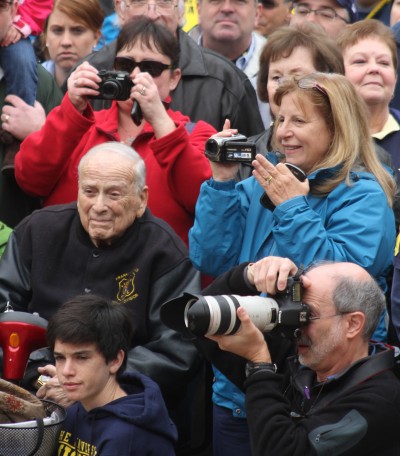Ann Arbor city council meeting (Aug. 8, 2013): Counting all public hearings and public commentary, members of the public accounted for just 20 minutes of the council’s meeting. Still, councilmembers stretched a relatively light agenda to about four hours.

Marcia Higgins (Ward 4) and Stephen Kunselman (Ward 3) share a light moment before the Aug. 8 meeting started. They had both contested Democratic primaries two days earlier. Kunselman prevailed in a narrow race against Julie Grand. Jack Eaton won the Ward 4 race. (Photos by the writer.)
An hour of the meeting was taken up with a discussion of street closures around Michigan Stadium on football game days. The street closures are part of an effort to increase safety by creating a vehicle-free zone around the stadium. It involves a cooperative effort with the University of Michigan, U.S. Department of Homeland Security and the city of Ann Arbor police department.
Those deliberations ultimately resulted in a modification of the original plan, so that the southbound lane of Main Street would not be closed until an hour before the start of the game.
Other parts of the plan were approved as originally proposed, starting three hours before kickoff: E. Keech Street between S. Main and Greene streets will be closed, and access to Greene Street from E. Hoover to E. Keech streets will be limited to parking permit holders; the westbound lane on E. Stadium Blvd. turning right onto S. Main Street (just south of the Michigan Stadium) will be closed; and S. Main Street except for the southbound lanes will be closed from Stadium Boulevard to Pauline.
The council also amended the plan to require a report by its Oct. 7 meeting on how well the procedures are working. Even with the modification to the plan and the requirement to brief the council on Oct. 7, the proposal to close streets on football Saturdays was approved on just a 7-4 vote, with dissent from Sabra Briere (Ward 1), Sumi Kailasapathy (Ward 1), Margie Teall (Ward 4) and Marcia Higgins (Ward 4). That neighborhood is located in Ward 4.
Also during the meeting, the council denied a requested street closure for a non-university event on South University Avenue. The requested closing was for “Beats, Eats, and Cleats,” sponsored by The Landmark apartment building. It was planned for the evening before a football game between the University of Michigan and the University of Notre Dame. Councilmembers expressed concerns about the probability of alcohol consumption.
Another 40 minutes of the meeting was taken up with discussion of a bike share program, which did have a direct connection to the University of Michigan. The council was asked to contribute $150,000 from the city’s alternative transportation fund. That money provided a 20% local match on a $600,000 Federal Highway Administration Congestion Mitigation Air Quality (CMAQ) grant that the Clean Energy Coalition (CEC) has received. The CMAQ funds have to be spent on capital, such as bikes and stations. Operations will be supported in the first three years of the program by UM at a level of $200,000 annually for a total of $600,000. The program will be operated by the CEC using B-Cycle as a vendor. The council’s vote on the bike share program was 9-2, with dissent from Sally Petersen (Ward 2) and Marcia Higgins (Ward 4).
Higgins also dissented on a council resolution that called upon the state legislature to repeal Michigan’s version of a “stand your ground” law, as well as to repeal legislation that prevents local municipalities from regulating the sale, transfer, transportation, or possession of firearms and ammunition. That resolution came after public commentary on the verdict in the Trayvon Martin case at the council’s previous meeting. Higgins agreed with the sentiments in the resolution, but said she thought it would have a greater impact if people spoke as individuals. Other councilmembers expressed some skepticism that the resolution would have much impact, but it received their support.
The Kerrytown Place project – an 18-unit townhouse development planned for the location of the former Orthodox Greek church on North Main Street – was subjected to only brief remarks. The council unanimously approved its requested rezoning and site plans.
In other business, the council approved a $10,000 design budget for a sidewalk on Waldenwood near King Elementary School. Construction of the sidewalk would allow a mid-block crosswalk to be moved to a four-way stop intersection.
The council also agreed to accept $202,370 from the Federal Farm and Ranch Land Protection Program (FRPP) to help the city purchase development rights on land in Lodi Township, southwest of the city.
Over dissent from Jane Lumm (Ward 2) and Sumi Kailasapathy (Ward 1), the council approved $18,500 to pay for public art administrator Aaron Seagraves’ contract through the end of 2013.
Among the nominations to boards and commissions announced at the meeting, two were significant: Rishi Narayan, founder and managing member of Underground Printing, to the board of the Ann Arbor Downtown Development Authority; and Jack Bernard, chair of the University of Michigan’s council for disability concerns, to the board of the Ann Arbor Area Transportation Authority. [Full Story]







